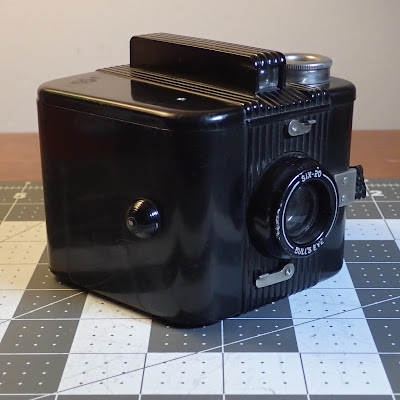Front
Back
Open for Loading Film
Latch
The shutter on the Bull's Eye can be set for instantaneous (about 1/50th second) or time exposure, and is not synchronized for flash. The lens is a fixed focus, uncoated meniscus lens that makes a reasonably sharp picture of subjects eight or more feet away. The aperture is about f/15. The Bull's Eye holds the film in a curve to sharpen the corners of the picture. The camera does not have a tripod socket. To make a time exposure you need to put the camera on a table or some other steady support. There is a knob on the side of the camera to let it rest evenly on a flat surface for portrait oriented pictures. The latch to open the camera for loading film is on the bottom. The cone lifts straight up from the camera. The film runs from right to left.
Kodak offered a portrait attachment that allowed pictures of a subject about 3-1/2' distant for a head and shoulders portrait. There also was a yellow pictorial filter used mostly to darken the skies for landscape pictures. A 1-5/16" Series VI adapter also fits to allow the use of Series VI lens accessories.
The Bull's Eye name came from Samuel N. Turner's Boston Camera Manufacturing Company. Mr. Turner was the first to put picture numbers on roll film and he put the once familiar little red window on his Bull's Eye cameras to show the numbers. Eastman bought the company in 1895 to get the film patent. A number of Eastman cameras have some variation of "bullseye" in the name. There is a 1950s Brownie Bull's-Eye Camera that is a fancier model than this one.
Like any other Brownie the Six-20 Bull's Eye takes a good picture as long as you stay within the limits of a camera without any adjustments for focus, aperture or shutter speed. Because modern films are better than the ones available 80 years ago, this Bull's Eye probably takes a better picture now than when it was new. Unlike a few other 620 film cameras, you can't squeeze a 120 spool into this one - you will need to re-spool your 120 film onto a 620 spool.
McKeown's Price Guide to Antique & Classic Cameras describes this model as "uncommon". The original list price for the Six-20 Bull's Eye was $3.00.
Compare to a similar picture made with a No. 2 Brownie in the post for February 22, 2020.




